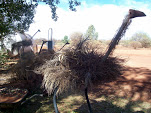How do you research the arts and social wellbeing in a rural community?
Well… first you have to define what you are talking about. I have gone for very broad and simple definitions as I was finding that other literature I was referring to was often very specific. Sometimes the author(s) would discount other forms of arts engagement or participation, or specify parameters, which in my opinion, does nothing for an understanding of how ART as opposed to any other activity impacts on wellbeing.
So for the definitions:
What is Art?
I’m calling art the product of creative expression and it includes the performing arts (such as dance, theatre, and music), the visual arts and craft, and the literary arts. I was also thinking of including multimedia arts, but I figured in some ways they would overlap performing, visual and literary. In whatever form or medium it comes, it is still a product of creative expression.
What is Social Wellbeing?
I’m calling it the social fabric of a community. So it includes things like belonging, trust, reciprocity, identity and place.
What is a rural community?
This can be tricky. It’s definitely located outside of the designated metropolitan areas of Australia’s capital cities. It is also a community that is based on primary industries such as agriculture, mining, pastoral, fisheries, etc. Defining something as rural, as opposed to regional, also implies a certain degree of remoteness, low population density and size, and low proportion of residents in an urban environment.
Once you’ve defined everything, you have to decide how you are going to measure it. Now this should follow on quite logically because how you understand the concepts that you want to research will determine how you measure it. So the research will take place in rural communities for all types of arts engagement. Sounds simple enough?
The hard part is the social wellbeing. So rather than make up my own way of measuring a concept that’s hard to define and even harder to measure I’m looking at adapting a number of measures already used in a variety of fields. These include quality of life scales, life satisfaction and happiness measures, even social capital indicators.
The biggest criticism of previous research is that there is, quite simply, a lack of robust data and evidence. The difficulty in trying to quantity effects, impacts or outcomes and what these outcomes should be has also been criticised. It’s even questionable as to whether we should be searching for an impact at all. Doesn’t this defeat the purpose of art for its own sake? Plus the methods of data collection, including the choice of the sample and the purpose, intention and bias of the researchers themselves has all been called into question.
In my opinion the intrinsic benefits of the arts is the primary reason why I myself engage. I like it and it makes me feel good. But I also think that if we can understand a little better why we enjoy it, what it does for us and how it impacts on communities we have a chance of building a better case for why opportunities to engage in the arts should be accessible and available to everyone.
I interviewed the former CEO of a local government authority in regional Australia and I think he summed it up very well. So I wanted to finish this entry with his quote:
“in terms of arts outcomes they were here, but in community development outcomes they were way up here. That was always one of the challenges; it was almost like a metaphor for something else. It wasn’t about what people were doing; it was about the effect of having them doing that on community spirit and cooperation and all those other kinds of things. That was something we found extraordinarily difficult to get through to the funding providers. They say ‘well, we don’t want to fund a festival,’ well you’re not funding a festival, you’re funding a community building activity that turned what could have been a war zone into a community. It was difficult trying to make that connection with some of the funding organisations, because I think the arts are undervalued as a tool for people learning other things. Because you cooperated on an arts project you’ve got the relationship where you can cooperate on other things too.”
Monday, June 9, 2008
Subscribe to:
Post Comments (Atom)




2 comments:
Hi Julia, Gemma from MtM here. Interesting stuff coming out. Agree community networking seems to be reliant upon activities & efforts of volunteer women and when these are lacking the community loses coherence. Using art as tool to implement positive change seems only plausible method to bring disparate groups together in common goal. Non competitive creative interaction more useful than sport events to create harmony. Art a means of helping define a communities identity & links. Darn up holes in social network. Gemma
The principle that art as tool can create healthy community attitudes amongst disparate residents is an approach that I am supporting in Mt Magnet. Working to a common goal in non competitive, creative way with goal not about money/perfection etc. but fun, communication, interaction, confidence, upskilling. Helps people appreciate other peoples talents previously unaware of. Chance to see your neighbour as three/four dimensional.
Post a Comment